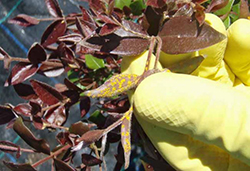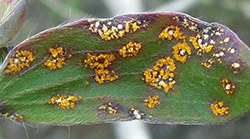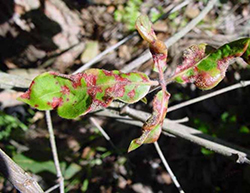
Myrtle rust
Myrtle rust in Australia

Myrtle rust (Puccinia psidii) is a fungal disease which infects plants in the Myrtaceae family. Common Australian Myrtaceae species include eucalyptus, willow myrtle, turpentine, bottlebrush, paperbark, tea tree and lilly pilly.
Since myrtle rust was first detected in NSW in April 2010 it has spread across the eastern Australian landscape in bushland reserves, home gardens, commercial operations and amenity settings such as parks and street plantings.
Myrtle rust can now be found in New South Wales, Victoria, Queensland, Tasmania and on the Tiwi Islands in the Northern Territory.
Background
When myrtle rust was first detected, a response was initiated to eradicate myrtle rust. The response was unsuccessful because myrtle rust spores are very easily dispersed by wind. In December 2010 eradication efforts were abandoned and transitioned to management.
Manage risk
Precautions to limit the spread of myrtle rust should be taken by people carrying out activities where there is potential to spread myrtle rust to vulnerable species or plant communities.
People engaged in activities associated with plants known to have, or likely to have myrtle rust should ask themselves:
- Will my actions spread myrtle rust to new areas?
- Will my actions spread myrtle rust to a vulnerable and important plant species or plant community?
- What can I do and how can I change my actions so that I do not spread myrtle rust?
Description
Myrtle rust is a fungal disease which attacks soft, actively growing leaves, shoot tips and young stems. Severity of infection and symptoms vary with different host species. Myrtle rust may also attack flowers and fruit of certain hosts.
Generally myrtle rust starts as small purple spots on leaves. Bright yellow spores form in pustules within these purple spots. Pustules fade to dull yellow and then grey as the infection ages. In severe infections, spots enlarge and merge, often causing leaf distortion.
Heavy infection can result in the death of soft plant material. Whole plant death may occur in highly susceptible hosts.
Plants with dark purple leaves such as willow myrtle 'Afterdark' (Agonis flexuosa cv 'Afterdark') do not display obvious symptoms of early infection. Disease becomes apparent once the bright yellow pustules form on both surfaces of the infected leaf.
On turpentine (Syncarpia glomulifera), initial symptoms appear as small purple flecks on young leaves then yellow pustules form on the lower surface.
Disease cycle

The visible yellow pustules of myrtle rust are made up of millions of powdery yellow spores. Spores are spread by wind to other host plants. Spores germinate and the myrtle rust fungus grows, piercing plant cells to obtain nutrients from the plant.
Myrtle rust spores require darkness, moisture and temperatures of 15–25°C to germinate. The first symptoms become visible within 3−5 days of initial infection. The new pustules can mature to release spores in 10–12 days. Spores can remain viable for up to three months.
Spread
Myrtle rust spreads naturally by wind, water, insects and animals. Spread can occur rapidly. Rust spores can travel very long distances and may infect susceptible plants many kilometres from the initial site of infection.
Myrtle rust spores can also spread over long distances if carried on infected plant material, contaminated equipment, vehicles and clothing.
Hosts
Myrtle rust infects plants in the family Myrtaceae.
Common plants that are susceptible to myrtle rust include:
- Eucalyptus species
- willow myrtle (Agonis flexuosa)
- turpentine (Syncarpia glomulifera)
- bottlebrush (Callistemon species)
- paperbark (Melaleuca species)
- water gum (Tristania neriifolia)
- tea tree (Leptospermum species)
- lilly pilly (Syzygium wilsonii)
New host species in Australia are continuously being discovered. To date, over 300 hosts have been recorded and can be found in the Australian Network for Plant Conservation host list.
Impact
The Australian environment

The plant family Myrtaceae dominates many major Australian ecosystems.
The short term impact of myrtle rust on mature trees is minimal. Continued infection of new seedlings and young trees over time may hinder the regeneration of susceptible species in natural forests. This may alter species balance and modify currently stable environments.
Genetic diversity in highly susceptible species could be greatly reduced and the structure and function of certain ecosystems could be adversely affected in the long term.
Commercial operations
Myrtle rust is a problem for commercial operations such as timber plantations and nurseries. Myrtle rust can lead to seedling death and increases costs of managing disease outbreaks.
The movement of Myrtaceae plant material is regulated in some states and trade can be impacted. At the time of writing Tasmania, Western Australia, Northern Territory and South Australia have quarantine restrictions in place for the importation of products of the Myrtaceae family from states known to have myrtle rust.
Distribution in Australia
Myrtle rust is widespread along the east coast of Australia from southern New South Wales to far north Queensland. In Victoria myrtle rust is found mainly in production nurseries around Melbourne. In Tasmania myrtle rust is found on properties on the north-west coast. Myrtle rust has been found on the Tiwi Islands off the coast of the Northern Territory.
Favourable conditions for the continued spread of myrtle rust include all coastal areas of Australia and inland areas with required humidity levels and susceptible hosts.
Myrtle rust is unlikely to establish in arid regions as dry conditions do not support disease growth and spread.
Prevention
Preventative measures can be taken to reduce the chance of myrtle rust being introduced onto properties, into unaffected plant communities or even in backyards. General measures include:
- Familiarise yourself with signs of myrtle rust
- Do not move plants known to be infected with myrtle rust
- In home gardens, remove healthy plants susceptible to myrtle rust before they become infected
- Launder clothing, hats and gloves worn during activities in high risk areas before using them in other areas
In commercial operations
- Check plants often for signs of myrtle rust
- Keep records of inspections and plant movements
- Advise all visitors and workers of biosecurity measures in place
- Disinfect equipment and personal effects such as glasses and mobile phones
- When purchasing new plants or cuttings ensure they are free from myrtle rust
- Keep new plants separate from existing plants until disease freedom can be assured or until treated with an appropriate fungicide
In the bush
- Always start jobs with clean equipment and clean vehicles
- Relocate planned activities from known or likely infected areas to another place if possible
- Comply with risk management and mitigation measures that business enterprises and sites of vulnerable plants and plant communities have in place
Management
Chemical treatment for infected plants
There are a number of fungicides available for the control of myrtle rust. Consult your local garden centre for a list of approved products.
Highly susceptible host plants are likely to become reinfected unless regularly treated. Rotation of fungicides containing different active ingredients is recommended to ensure fungicide applications remain effective.
Removal of infected parts or whole plants
Removing plants infected with myrtle rust, or pruning infected plant parts, can help reduce disease spread and minimise chance of future infection. Affected plants should be removed and disposed of appropriately to minimise the spread of myrtle rust:
- Spray infected and nearby plants with a fungicide to kill spores 3-4 days prior to removal
- Before being removed, smaller plants and plant parts should be enclosed in a plastic bag
- Larger plants that do not fit in bags can be cut into smaller pieces and covered with black plastic for 3-4 weeks in a sunny spot. This process is called solarisation and kills remaining spores
- When disposing of plants, small plants enclosed in plastic bags can be put in a normal waste bin - NOT the green waste bin. Larger plants can be taken to the tip - NOT the green waste section
Arrangements for interstate trade
An Interstate Certification Assurance (ICA) arrangement, ICA-42 (PDF, 373.59 KB) Production Nursery freedom, treatment and inspection for myrtle rust is in place to assist businesses trading in myrtle rust host plants to comply with interstate quarantine requirements.As market access requirements may be subject to change, the requirements for all States and Territories should be checked prior to export. Please visit the ICA website for further information.
Further reading
Arrive Clean, Leave Clean, Commonwealth of Australia 2015 (PDF, 6.92 MB)
Myrtle Rust Biosecurity Fact Sheet, DPIPWE Tasmania 2015 (PDF, 459 KB)

